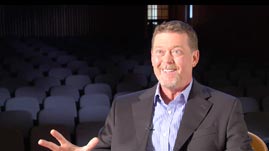Teachers' Domain - Digital Media for the Classroom and Professional Development
User: Preview

Source: Perkins Webcasts: "Adapting Environments for Individuals with Vision Loss – Darick Wright"


Learn how lighting, glare, contrast, and color can either enhance or distort the school, work, or home environment of people with visual impairments, in these videos produced by Perkins School for the Blind. Using camera techniques to emphasize the appearance of environments with and without these elements, each video provides tips for assessing an environment and choosing the best design adaptation to improve visual information.
Contrast and Contrast Sensitivity (Video)
Lighting and Positioning (Video)
Glare (Video)
Reducing Visual Clutter (Video)
Visual Cues for Orientation (Video)
Strategies and Self-Advocacy (Video)
When we think of adapted environments, and accommodations for individuals with disabilities, we may only think as far as adaptive devices, or speech-enabled aids. Darick Wright, of the New England Eye Clinic, explains that the most obstructive elements in the daily environment are organic in nature. These videos show how to assess the impact of contrast, lighting, color, and surface textures on visual information and provide practical suggestions for alleviating obstacles.
These videos also explain the importance of a visually impaired person understanding the nature of his or her own diagnosis. With this knowledge, individuals can evaluate their needs for accommodation, and work with employers, family members, or schools for the best environmental adaptations for their needs.
 Loading Standards
Loading Standards